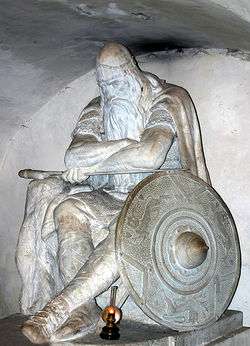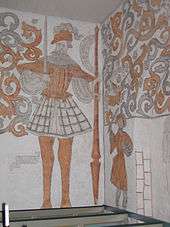Ogier the Dane

Ogier the Dane (French: Ogier le Danois or archaically Ogier de Danemarche, Danish: Holger Danske) is a legendary character who first appears in an Old French chanson de geste, in the cycle of poems Geste de Doon de Mayence.
Historical references
The 12th-century Danish chronicler Saxo Grammaticus was not familiar with the character, and Ogier has not been connected to any historic event in Denmark.[1] A chronicle from St Martin's monastery in Cologne claims that the monastery had been pillaged by the Saxons in 778, but that it was rebuilt by "Olgerus, dux Daniæ" ("Olger, War-Leader of the Danes"), with the help of Charlemagne.[1]
Poetry, romances and literature
Ogier the Dane first appears as one of Charlemagne's knights, in Chanson de Roland (written ca. 1060 AD), without reference to any known historical figure. He plays only a minor part in this poem, and his only link to Denmark seems to be his name, Ogier le Danois.
Ogier becomes the main character in the poem La Chevalerie Ogier de Danemarche (written ca. 1200-15 AD). Here he is the son of the Danish king Geoffrey, who is the enemy of Charlemagne, given as a hostage to Charlemagne. Ogier grows into a heroic character, who begets a son who was slain by Charlot, son of Charlemagne. Seeking revenge, Ogier kills Charlot and is barely prevented from killing Charlemagne, with whom he is at war for seven years. They eventually make peace and Ogier goes to fight at Charlemagne's side against the Saracens, in which battle he slays the giant Brehus.
After this poem was written Ogier becomes increasingly popular in European literature.
Ogier the Dane had a sword named Cortana or Curtana. According to the legend, the weapon bore the inscription: "My name is Cortana, of the same steel and temper as Joyeuse and Durendal."[2] The 13th-century Prose Tristan states that Ogier inherited the sword of the Arthurian knight Tristan, shortening it and thus naming it Cortaine. This suggests a connection to Henry III of England's coronation sword Curtana, which was said to have been Tristan's sword, and which had its end cut off. The sword remains in use in the coronation of the British monarchs.[3]

It is likely that he became known in Scandinavia in the 15th century through the translation of Karlamagnús saga, but he rapidly became popular and he is depicted on 15th- and 16th-century paintings in two churches in Denmark and Sweden.[1]
In 1515, Kristiern Pedersen was living in Paris, and there he translated a prose novel based on the rhyming chronicles into the Danish Olger Danskes krönike, which was printed in 1534.[1] Pedersen made Ogier into the son of a Danish king named "Godfred" who leaves Ogier as hostage to Charlemagne.[1] This translation quickly became popular in Denmark.[1]
Like Frederick Barbarossa, Saint Wenceslas and King Arthur, in Danish legend Ogier becomes a king in the mountain; he is said to dwell in the castle of Kronborg, his beard grown down to the floor. He will sleep there until some day when the country of Denmark is in peril, at which time he will rise up and save the nation. The largest World War II Danish resistance group, Holger Danske, was named after the legend.
In some versions, Morgue le Faye (commonly known today as Morgan le Fay) takes him to Avalon, from where he returns after two hundred years to save France. According to the tour guides of Kronborg Castle, legend has it that Holger sat down in his present location after walking all the way from his complete battles in France.
On Rönneberga slopes, outside Landskrona in south Sweden (formerly a part of Denmark), there is a burial mound named Holger Danske mound.
The 1789 opera Holger Danske, composed by F.L.Æ. Kunzen with a libretto by Jens Baggesen, had a considerable impact on Danish nationalism in the late 18th century. It spawned the literary "Holger feud," which revealed the increasing dissatisfaction among the native Danish population with the German influence on Danish society. Amongst others, the Danish intellectual Peter Andreas Heiberg joined the feud by writing a satirical version entitled Holger Tyske ("Holger the German") ridiculing Baggesen's lyrics. During the German Occupation of Denmark, presentation of the same opera in Copenhagen became a manifestation of Danish national feeling and opposition to the occupation.
Modern works
Poul Anderson's fantasy novel Three Hearts and Three Lions (ISBN 0-671-72186-0) (1961) draws upon these legends and also alters them. Its protagonist Holger Carlsen (a Danish resistance fighter) is transported to a fantasy alternate history where the Matter of France is historical. He eventually learns that he is Ogier the Dane.
In his 2010 novel I Curse the River of Time (translated into English by Charlotte Barslund, with the author), Norwegian novelist Per Petterson describes a small ferry sailing between Norway and Denmark with the name Holger Danske; one of the main characters - a dying Danish woman going home - feels accepted and understood by its crew. She has lost a son some years ago. The ferry's name may or may not be relevant to the story, which has many interwoven strands.
References
- 1 2 3 4 5 6 The article Holger Danske in Nordisk familjebok (1909)
- ↑ Bullfinch's Mythology, Legends of Charlemagne, Chapter 24
- ↑ Harper-Bill, Christopher, and Ruth Harvey (1990). The Ideals and Practice of Medieval Knighthood III, p. 134. Boydell Press. ISBN 0851152651.
External links
| Wikimedia Commons has media related to Holger Danske. |